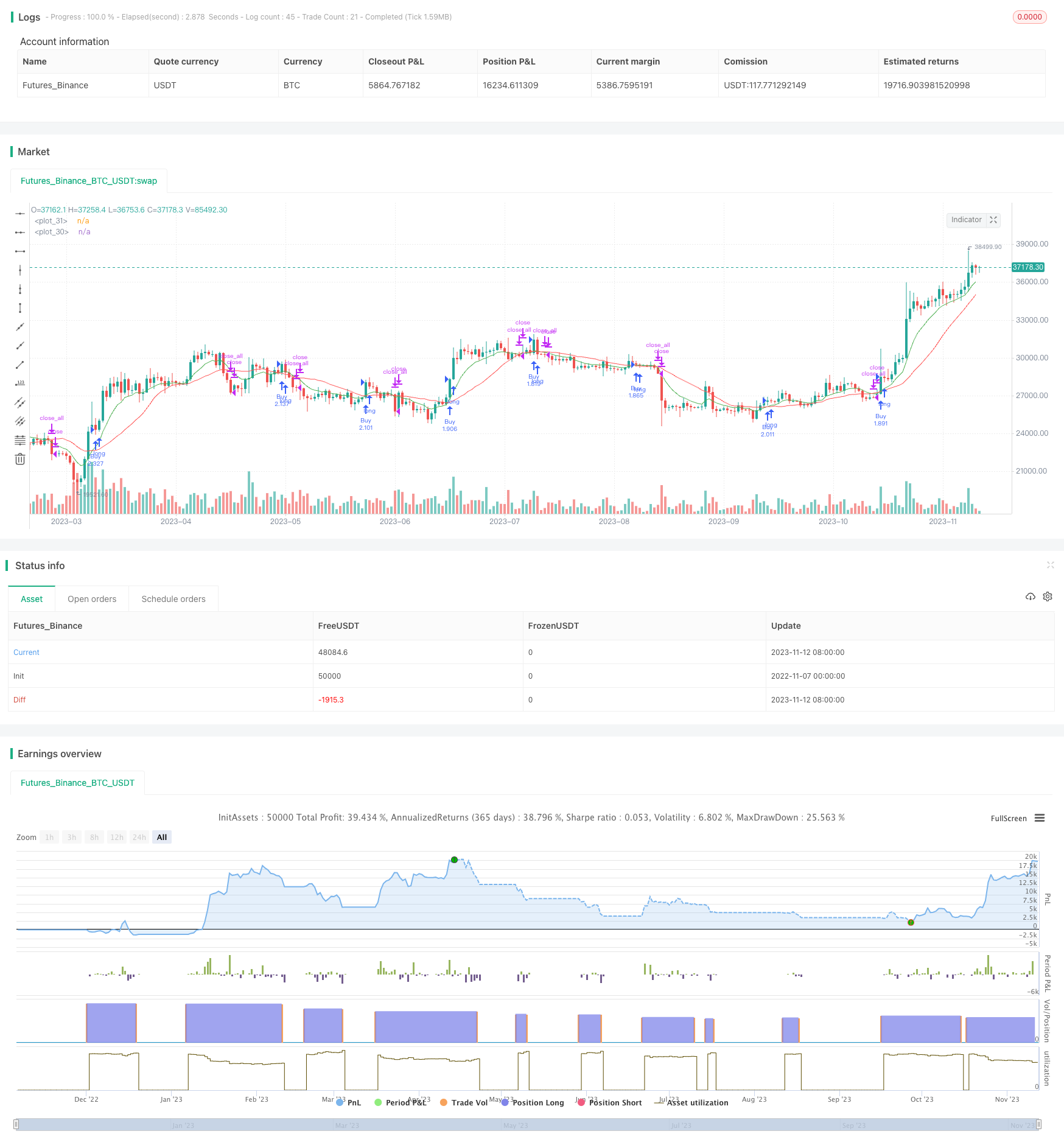
概述
双轨跟踪震荡分型策略是一种基于布林带和EMA指标的量化交易策略。该策略 attempts to capture short-term price fluctuations through identifying oscillator patterns based on Bollinger Bands and EMA.
策略原理
该策略同时使用布林带和EMA作为技术指标。布林带包含上轨、中轨和下轨,能够判断价格是否处于震荡区间。EMA是一种趋势跟踪指标,能够判断价格趋势。
该策略首先计算布林带的中轨,也就是价格的n日简单移动均线,其中n值默认为20天。布林带上轨和下轨分别为中轨加/减两个标准差。然后计算9日EMA。
当价格上穿EMA时,视为买入信号;当价格下穿EMA时,视为卖出信号。这样,EMA作为快速均线,能够捕捉价格短期趋势;而布林带中轨作为慢速均线,能过滤掉部分假信号。
所以,该策略通过EMA和布林带的双轨跟踪,尽可能捕捉价格的短期震荡。当EMA上穿中轨时买入,EMA下穿中轨时卖出。
策略优势分析
这种双轨跟踪策略有以下几个优势:
使用EMA和布林带中轨双轨跟踪,能够同时判断趋势和震荡,更准确地捕捉短期价格波动。
EMA作为快速均线,布林带中轨作为慢速均线,二者配合使用,可以有效过滤假信号,提高信号质量。
指标参数可调整,n值和布林带标准差可根据市场调整,适应性强。
策略思路简单清晰易于实现,非常适合短期震荡行情。
可适当优化参数,结合其他指标过滤,进一步提高策略稳定性。
风险分析
该策略也存在一些潜在风险:
布林带上下轨容易形成支撑和压力,可能会提前触发止损。
EMA和布林带中轨交叉时,价格可能出现背离,发出错误信号。
大幅趋势行情时,EMA容易形成san杯底买点或三山顶卖点,可能错过趋势。
震荡行情减弱时,交易信号将明显减少,无法持续盈利。
参数设置不当可能导致过度交易或漏失交易机会。
交易费用会降低实际盈利,需要控制好仓位规模。
策略优化方向
该策略可以从以下几个方面进行优化:
增加成交量等指标,过滤信号质量不佳的交叉信号。
结合RSI等超买超卖指标,避免买卖点出现在极端区域。
根据ATR值来设置止损和止盈,使止损更合理。
增加对趋势的判断,避免趋势行情下产生错误信号。
优化参数,如EMA周期、布林带参数等,使之更符合不同市场环境。
采用机器学习方法动态优化参数,使策略更具鲁棒性。
采用算法交易,设置更严格的入场和出场条件,减少人为干预。
总结
双轨跟踪震荡分型策略同时利用EMA和布林带双轨跟踪价格,通过EMA上穿中轨买入,EMA下穿中轨卖出,捕捉短期价格震荡,是一个较为简单实用的短线策略。该策略具有趋势判断和滤除假信号的优势,但也存在一定的风险。通过不断优化参数设置、入场出场条件等,该策略可以变得更稳定可靠,适用于更多市场环境,是一个值得学习和应用的策略思路。
/*backtest
start: 2022-11-07 00:00:00
end: 2023-11-13 00:00:00
period: 1d
basePeriod: 1h
exchanges: [{"eid":"Futures_Binance","currency":"BTC_USDT"}]
*/
//@version=4
strategy(shorttitle="BBXEMA", title="Bollinger Bands Cross EMA", default_qty_type=strategy.percent_of_equity, default_qty_value=100, overlay=true)
length = input(20, minval=1)
lengthEMA = input(9)
src = input(close, title="Source")
srcEMA = input(close, title="Source EMA")
//mult = input(2.0, minval=0.001, maxval=50)
// === INPUT BACKTEST RANGE ===
FromYear = input(defval = 2019, title = "From Year", minval = 2009)
FromMonth = input(defval = 1, title = "From Month", minval = 1, maxval = 12)
FromDay = input(defval = 1, title = "From Day", minval = 1, maxval = 31)
ToYear = input(defval = 9999, title = "To Year", minval = 2009)
ToMonth = input(defval = 12, title = "To Month", minval = 1, maxval = 12)
ToDay = input(defval = 31, title = "To Day", minval = 1, maxval = 31)
// === FUNCTION EXAMPLE ===
start = timestamp(FromYear, FromMonth, FromDay, 00, 00) // backtest start window
finish = timestamp(ToYear, ToMonth, ToDay, 23, 59) // backtest finish window
window() => true
basis = sma(src, length)
EMA = ema(srcEMA,lengthEMA)
//dev = mult * stdev(src, length)
//upper = basis + dev
//lower = basis - dev
Buy = crossover(EMA,basis)
Sell = crossunder(EMA,basis)
bb = plot(basis, color=color.red)
signal = plot(EMA, color=color.green)
//p1 = plot(upper, color=color.blue)
//p2 = plot(lower, color=color.blue)
//fill(p1, p2)
strategy.entry("Buy",true,when=window() and Buy)
strategy.close_all(when=window() and Sell)